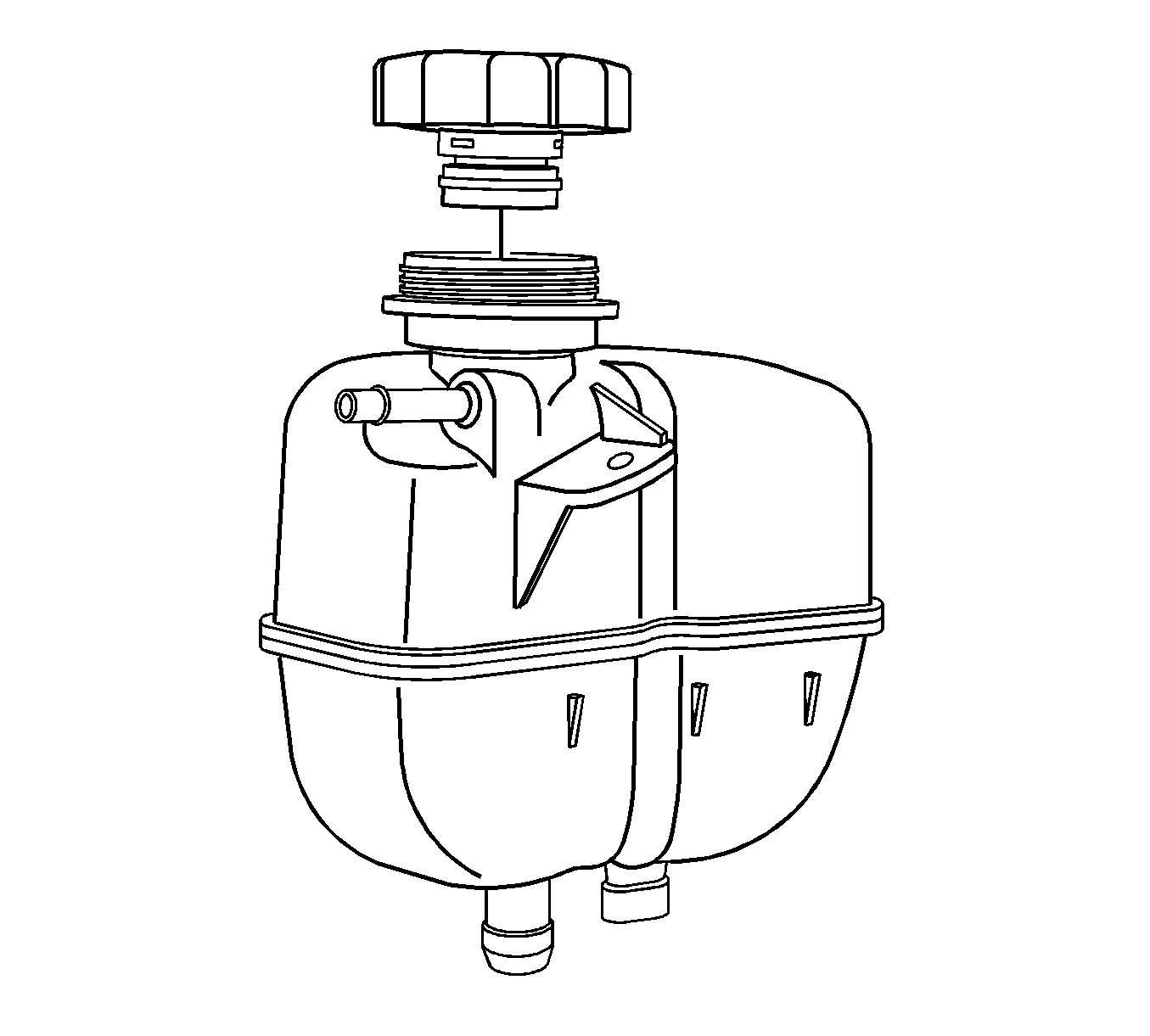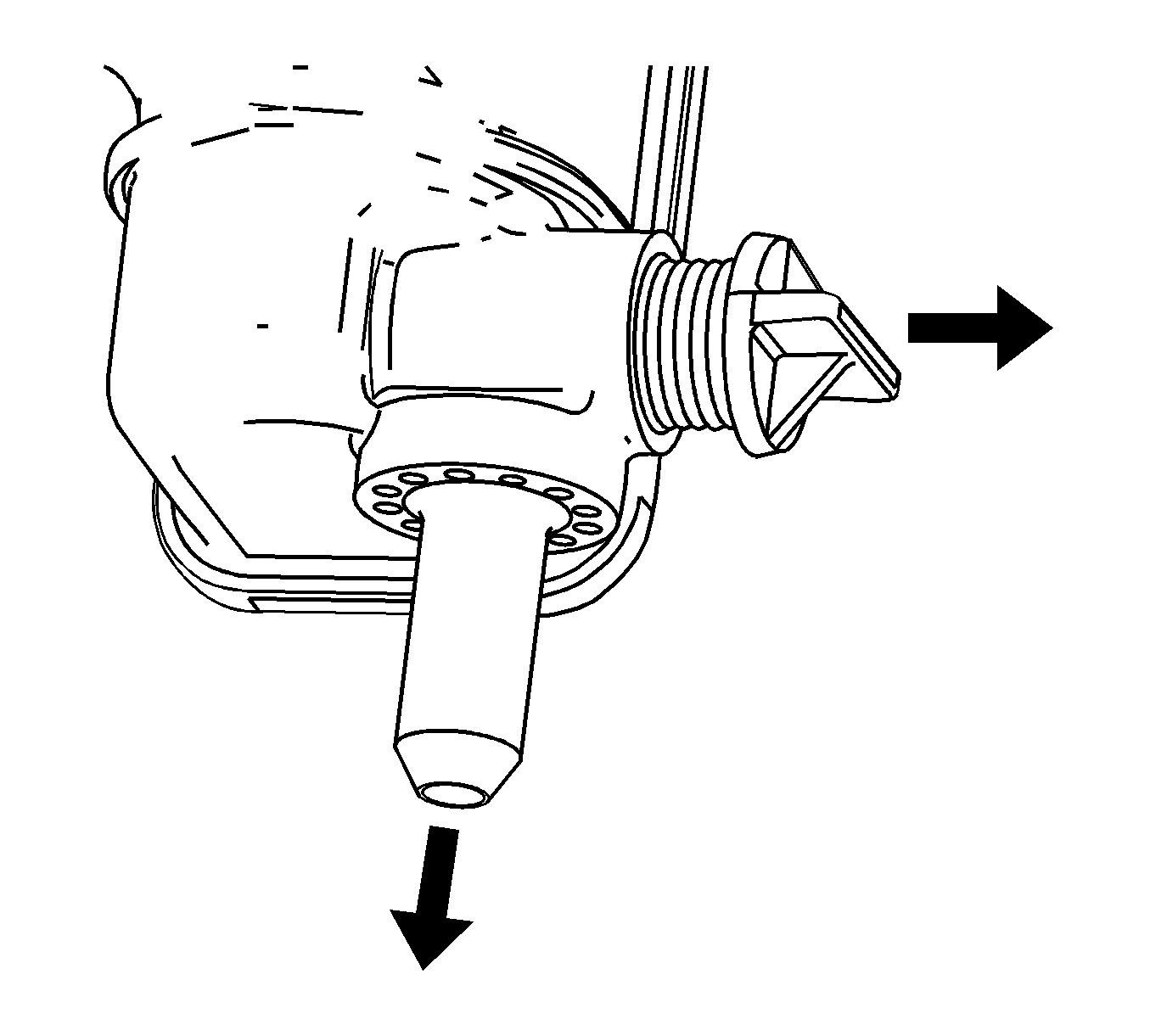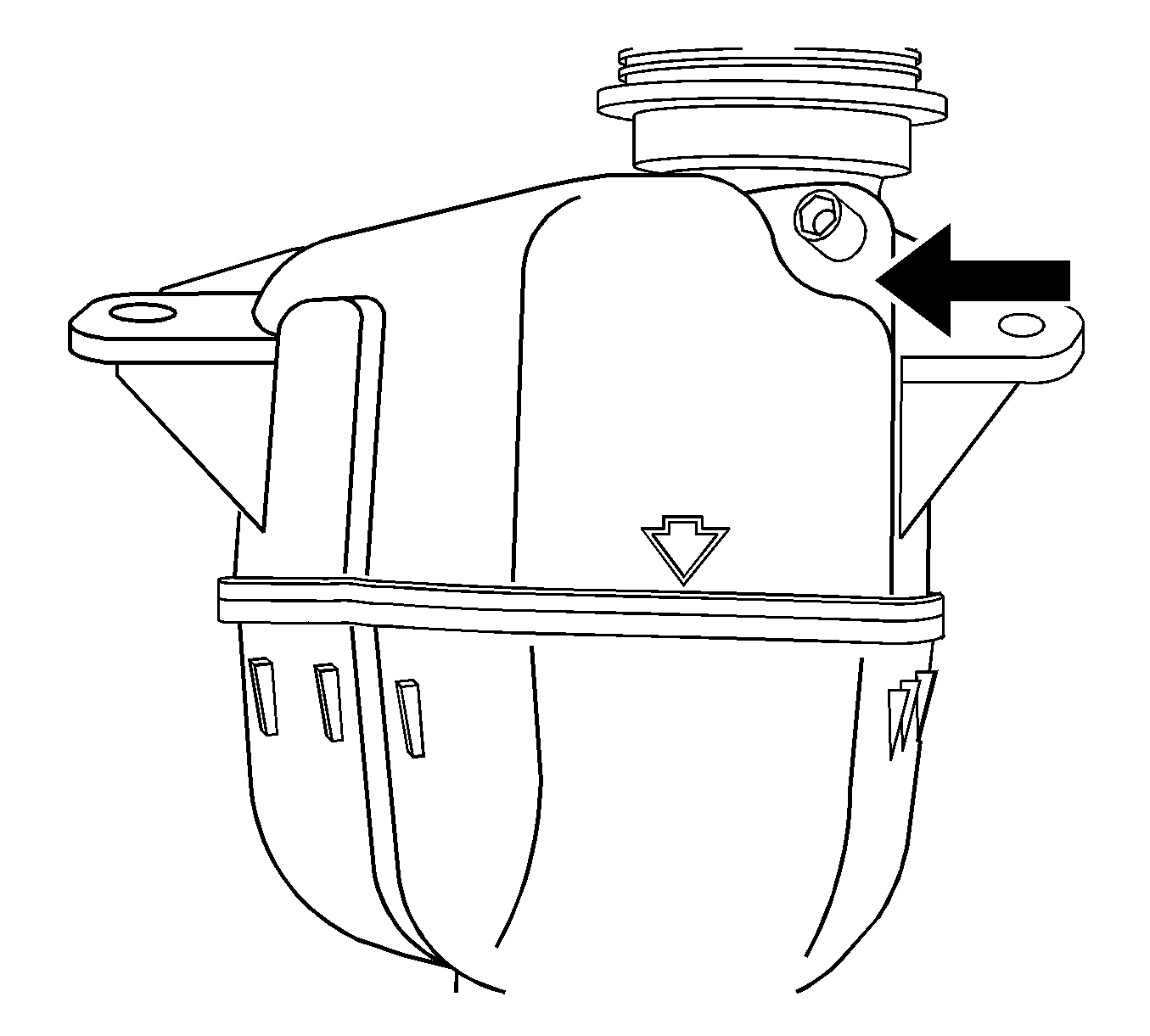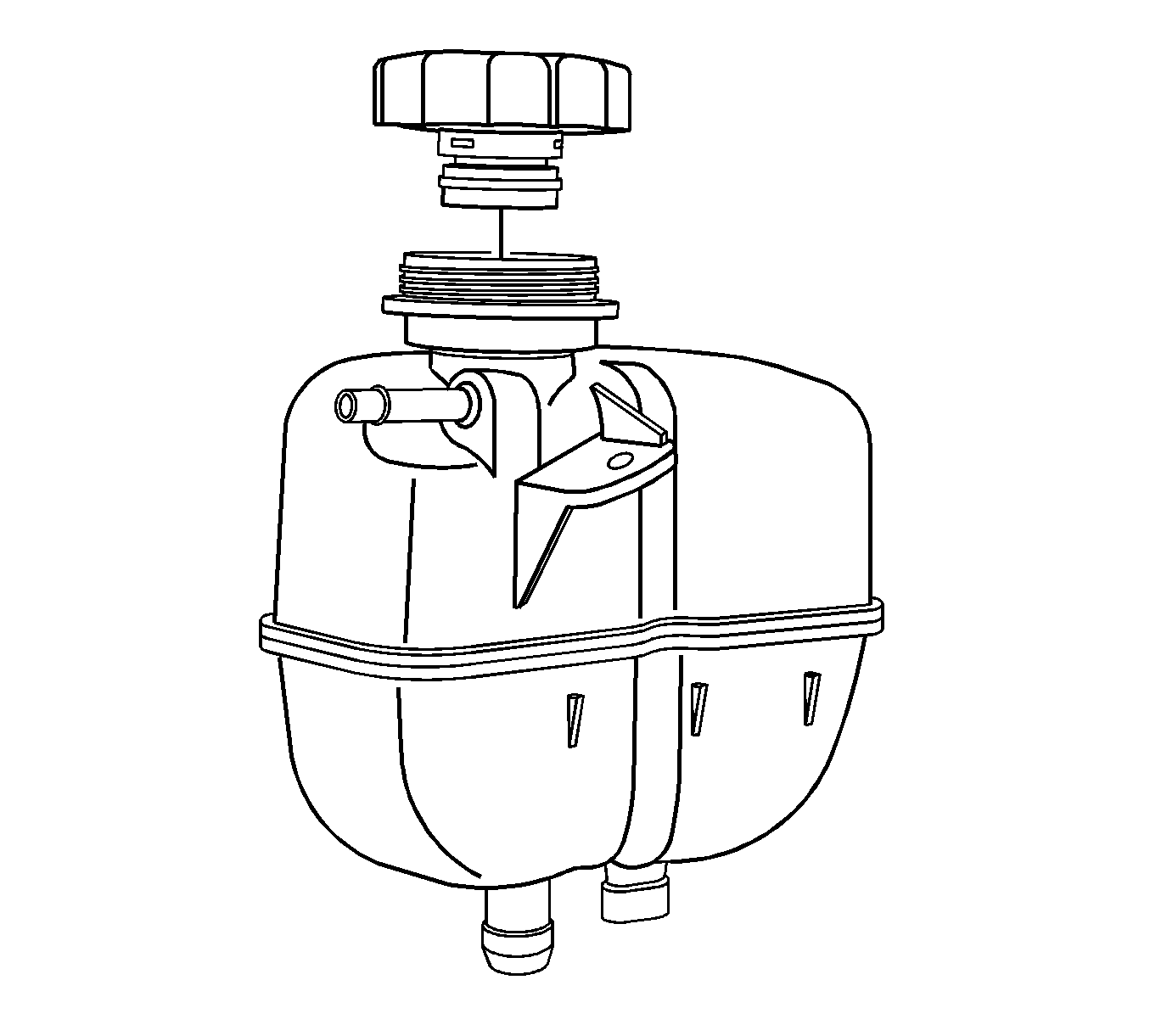Cooling System Draining and Filling LE5 Static Fill
Tools Required
J 26568 Coolant and Battery Fluid Tester
Draining Procedure
Caution: With a pressurized cooling system, the coolant temperature in the radiator can be considerably higher than the boiling point of the solution at atmospheric pressure. Removal of the surge tank cap, while the cooling system is hot and under high pressure, causes the solution to boil instantaneously with explosive force. This will cause the solution to spew out over the engine, the fenders, and the person removing the cap. Serious bodily injury may result.
- Unscrew the surge tank cap to remove vacuum when draining coolant.
- Raise the vehicle. Refer to Lifting and Jacking the Vehicle .
- Place a container under the radiator drain.
- Unscrew the radiator drain plug until coolant flows out the radiator drain.
- If a complete block drain is required, remove the coolant drain plugs. Refer to Draining Fluids and Oil Filter Removal .
- Follow the appropriate procedure based on the condition of the coolant:


| • | Normal in appearance--Follow the filling procedure. |
| • | Discolored--Follow the flush procedure. Refer to Flushing . |
Fill Procedure
- Install the engine block coolant drain plugs. Refer to Engine Block Assemble .
- Close the radiator drain plug.
- Lower the vehicle.
- Vehicle should be level.
- Slowly add a mixture of 50/50 DEX-COOL® antifreeze and clean drinkable water until the level stabilizes approximately 2 in (50.8 mm) above the weld seam on the surge tank. Refer to Approximate Fluid Capacities .
- Start the engine. The coolant level in the surge tank will drop.
- Continue filling the surge tank as necessary to maintain the level at the cold fill mark.
- When the coolant in the upper radiator hose feels warm, install the surge tank cap.
- Continue to run the engine at 2,000 RPM until the engine cooling fans turn ON.
- Let the engine idle for 30 seconds.
- Turn the engine OFF and allow the engine to cool down.
- Adjust the coolant level.
- Inspect the concentration of the engine coolant using J 26568 .
- Rinse away any excess coolant from the engine and the engine compartment.
Notice: The procedure below must be followed. Improper coolant level could result in a low or high coolant level condition, causing engine damage.

Important: Do not overfill and allow the coolant to cover the surge tank inlet hose port.

Important: DO NOT exceed 2,200 RPM.
Important: Coolant should be at the full cold mark when the system cools.
Cooling System Draining and Filling LY7, LZ4, Static Fill
Tools Required
J 26568 Coolant and Battery Fluid Tester
Draining Procedure
Caution: With a pressurized cooling system, the coolant temperature in the radiator can be considerably higher than the boiling point of the solution at atmospheric pressure. Removal of the surge tank cap, while the cooling system is hot and under high pressure, causes the solution to boil instantaneously with explosive force. This will cause the solution to spew out over the engine, the fenders, and the person removing the cap. Serious bodily injury may result.
- Unscrew the surge tank cap to remove vacuum when draining coolant.
- Raise the vehicle. Refer to Lifting and Jacking the Vehicle.
- Remove the engine splash shield. Refer to Engine Splash Shield Replacement
- Place a container under the radiator drain.
- Unscrew the radiator drain plug until coolant flows out the radiator drain.
- If a complete block drain is required, remove the coolant drain plugs. Refer to Draining Fluids and Oil Filter Removal for the 3.5L engine, or Engine Block Disassemblefor the 3.6L engine.
- Follow the appropriate procedure based on the condition of the coolant:


| • | Normal in appearance--Follow the filling procedure. |
| • | Discolored--Follow the flush procedure. Refer to Flushing. |
Fill Procedure
- Install the engine block coolant drain plugs. Refer to the appropriate procedure:
- Close the radiator drain plug.
- Install the engine splash shield. Refer to Engine Splash Shield Replacement
- Lower the vehicle.
- Vehicle should be level.
- Add a mixture of 50/50 DEX-COOL® antifreeze and clean drinkable water until the level stabilizes approximately 25.4 mm (1 in) above the weld seam on the surge tank. Refer to Approximate Fluid Capacities.
- Install the surge tank cap.
- Start the engine and run at 2,000 RPM until the engine cooling fans turn ON.
- Turn the engine OFF and allow the engine to cool down.
- Remove the surge tank cap.
- Refill to approximately 25.4 mm (1 in) above the weld seam on the surge tank.
- Install the surge tank cap.
- Inspect the concentration of the engine coolant using J 26568 .
- Inspect the concentration of the engine coolant using J 26568 .
- Install the surge tank cap.
- Rinse away any excess coolant from the engine and the engine compartment.
Notice: The procedure below must be followed. Improper coolant level could result in a low or high coolant level condition, causing engine damage.
| • | Engine Block Assemble for the 3.5L engine. |
| • | Engine Block Assemble for the 3.6L engine. |


Important: DO NOT exceed 2,200 RPM.
Cooling System Draining and Filling LAT Static Fill
Tools Required
J 26568 Coolant and Battery Fluid Tester
Draining Procedure
Caution: With a pressurized cooling system, the coolant temperature in the radiator can be considerably higher than the boiling point of the solution at atmospheric pressure. Removal of the surge tank cap, while the cooling system is hot and under high pressure, causes the solution to boil instantaneously with explosive force. This will cause the solution to spew out over the engine, the fenders, and the person removing the cap. Serious bodily injury may result.
- Unscrew the surge tank cap to remove vacuum when draining coolant.
- Raise the vehicle. Refer to Lifting and Jacking the Vehicle .
- Place a container under the radiator drain.
- Unscrew the radiator drain plug until coolant flows out the radiator drain.
- If a complete block drain is required, remove the coolant drain plugs. Refer to Draining Fluids and Oil Filter Removal .
- Follow the appropriate procedure based on the condition of the coolant:


| • | Normal in appearance--Follow the filling procedure. |
| • | Discolored--Follow the flush procedure. Refer to Flushing . |
Fill Procedure
- Install the engine block coolant drain plugs. Refer to Engine Block Assemble .
- Close the radiator drain plug.
- Lower the vehicle.
- Vehicle should be level.
- Slowly add a mixture of 50/50 DEX-COOL® antifreeze and clean drinkable water until the level stabilizes approximately 50.8 mm (2 in) above the weld seam on the surge tank. Refer to Approximate Fluid Capacities .
- Start the engine. The coolant level in the surge tank will drop.
- Continue filling the surge tank as necessary to maintain the level at the cold fill mark.
- When the coolant in the upper radiator hose feels warm, install the surge tank cap.
- Continue to run the engine at 2,000 RPM until the engine cooling fans turn ON.
- Let the engine idle for 30 seconds.
- Turn the engine OFF and allow the engine to cool down.
- Adjust the coolant level.
- Inspect the concentration of the engine coolant using J 26568 .
- Rinse away any excess coolant from the engine and the engine compartment.
Notice: The procedure below must be followed. Improper coolant level could result in a low or high coolant level condition, causing engine damage.

Important: Do not overfill and allow the coolant to cover the surge tank inlet hose port.

Important: DO NOT exceed 2,200 RPM.
Important: Coolant should be at the full cold mark when the system cools.
